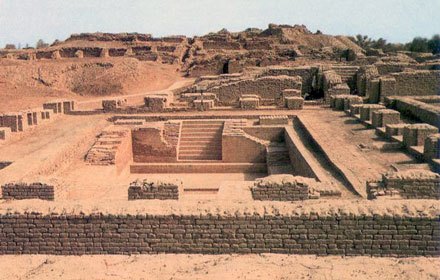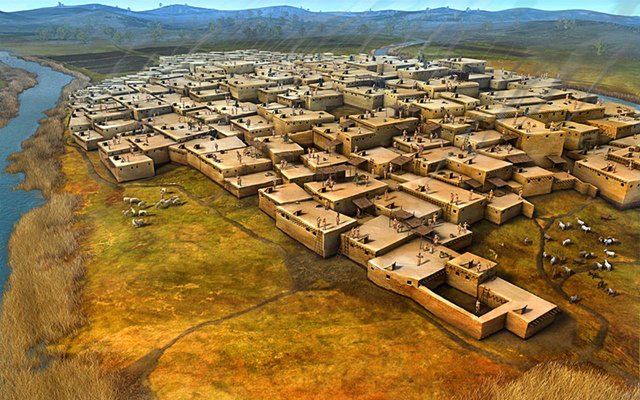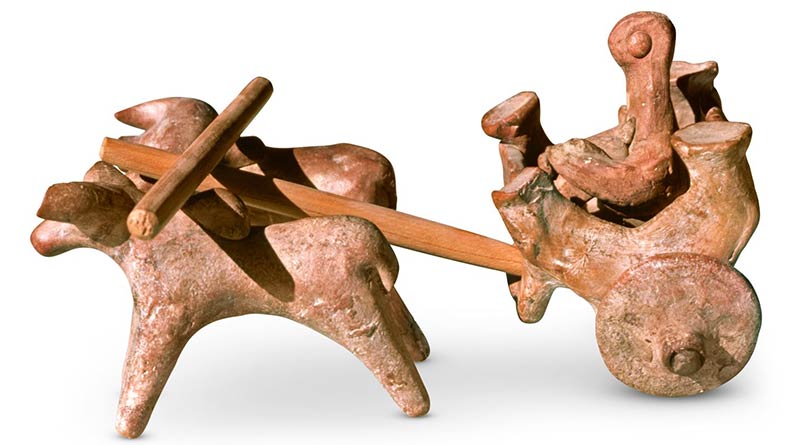DEAR STEEMER FRIENDS

Indus Valley Civilization (from 3300 BCE to 1700 BC) [1] is one of the major civilizations of the ancient river valley civilizations of the world. [2] According to research published in the respected magazine Nature, this civilization is at least 8000 years old. It is also known as the Harappan civilization and the 'Indus-Saraswati civilization'. It was developed on the banks of Indus and Ghaggar / Hukda (ancient Saraswati). [3] Mohanjodaro, Kalibanga, Lothal, Dholavira, Rakhijiri and Harappa were its main centers. In December 2014, Bhiddana was considered as the oldest city ever discovered by the Indus Valley Civilization. Based on the excavations of British period, archaeologists and historians estimate that it was a highly developed civilization and these cities are often settled and left wrecked.
1826 Charles Masen first discovered this old civilization. Cunningham conducted a survey about this civilization in 1856. During the construction of the Central Railway line from Karachi in Lahore in 1856, the Burton brothers gave information to the government about Harappan site. In the same order, in 1861, under the guidance of Alexander Cunningham, the Indian Archeology Department was established. John Marshall was made Director General of the Indian Archaeological Department (ASI) by Lord Curzon in 1904. Fleet wrote an article about this old civilization. In 1921, Dayam Sahni excavated Harappa. Thus the name of this civilization was named Harappa civilization. This civilization was spread in the Indus river valley, hence its name was named Indus Valley Civilization. Due to the rise of the cities for the first time, it is also called the first urbanization. Due to the use of bronze for the first time, it is also called Bronze Civilization. 1400 centers of Indus Valley Civilization have been discovered, out of which 925 centers are in India. Around 80% of the area is surrounded by the Saraswati river and its tributaries. So far only three percent of the total searches have been done.

Nomination
The area of Indus Valley Civilization was very extensive. The dignity of Harappa and Mohenjodaro has been found in this civilization. Hence, the scholars called it the civilization of the Indus Valley, because this region comes in the region of Indus and its tributaries, but later in the areas of Ropar, Lothal, Kalibanga, Vanmali, Rangapur etc. also found the remains of this civilization which are found in Indus and Its tributaries were out of the fields. Hence, many historians consider this civilization more appropriate to name the Harappan civilization as being Harappan, the main center of this civilization. In 1924, John Marshall, Director General, Archaeological Survey of India, wrote three important texts about Indus Civilization.

Expand
The area of this civilization was many times larger and larger than the area of all the ancient civilizations of the world. [4] The center of this mature civilization was in Punjab and Sindh. Thereafter, its expanse is in the direction of south and east. Thus, under the Harappan culture, not only the parts of Punjab, Sindh and Balochistan, but also the marginal portion of Gujarat, Rajasthan, Haryana and Western Uttar Pradesh. Its dispersal ranges from Rahmandari in the north to Damabad (Maharashtra) in the south and from Sutkagandor in Makran coast of Balochistan to Meerut and Kurukshetra in the north east. In the initial expansion which was achieved, the entire region was triangular (from north of Jammu to Manga, to Bhogotara of Gujarat in the south and Sutkagandor in Afghanistan to the east, Meerut of Uttar Pradesh and its area was 12,99,600 square kilometers). In this way, this area is bigger than modern Pakistan, bigger than ancient Egypt and Mesopotamia. In the third and second millennium BC, the region of any civilization in world weight was not bigger than the Harappan culture. So far, the total 1000 sites of this culture have been discovered in the Indian subcontinent. Some of these are of early stages, some of the mature state and some of the succulent states. There are fewer places of mature age. Only half of these can be given the name of the city. Two of these cities are very important - the rush of Punjab's Harappa and Sindh (literally meaning the mound of the demons). Both are in current Pakistan. Both were 483 km away from each other and were connected by river Indus. The third city was Mohan, which was located at Chhanhudo, 130 km south of the clock, the fourth town on the site of Lothal on the Gulf of Khambhat in Gujarat. Apart from this, Kalibanga (literally meaning-black bangles) and Hissar district of Haryana were created in the northern part of Rajasthan. All these sites have the philosophy of mature and advanced Harappa culture. In the seaside cities of Sutkagandor and Surkotada, the mature state of this culture is also seen. These two characteristics are of one city fortification. North Harappan state is also found at Rangpur and Rosadi sites in the Hardyan Peninsula of Gujarat. The information of this civilization was first received by Charles Man in 1826.

Town building plan
The most important thing about this civilization was the developed town-building plan here. Harappa and Mohan Jodaro had their fortresses in the cities where the family of the ruling class lived. In each city, one below the fort was a lower level city where ordinary people lived in brick houses. The special thing about these municipal buildings was that it was configured as a trap. That is, the roads used to cut each other at right angles and the city was divided into several rectangular sections. These things were applicable to all Indus settlements even if they were small or large. The buildings of Harappa and Mohan Joddo grew up. The monuments there are proof that the rulers there were the most skilled in mobilizing and tax collection. By seeing the large bricks of bricks, the ordinary people will also feel how proud and dignified these rulers were.
Mohan Jodaro's most famous site is the large public bath, whose reservoir is in the mound of the fort. This is a beautiful example of brick architecture. It is 11.88 meters long, 7.01 meters wide and 2.43 meters deep. Stairs are going on to the floor at both ends. There are clothes changing rooms next door. The bathroom floor is made of ripe bricks. There is a large well in the adjacent room whose water was removed and put in hose. There is an outlet in the corner of the hauz, which causes the water to flow into the drain. It is believed that this giant bath will be made for bathing of Dharmmuthan, which is essential for traditional religious activities in India. The largest structure of Mohan Jodado is - Garner, which is 45.71 meters long and 15.23 meters wide. In the fort of Harappa, six storied ones have been found, which are standing in two sides on the bricks of bricks. Every room is 15.23 m Lengthy and 6.09 m It is wide and is a few meters away from the banks of the river. The area of these twelve units is approximately 838.125 square meters. That is almost as much as the Mohan Jodro's storehouse. The Harappan has open floors in the south of the storehouses and on it there are two circular circular bars of brick. Grains of wheat and barley are found in the cracks of the floor. From this it appears that there was a grain of harvest on these papules. Two-room barracks were also found in Harappa, which were probably made for laborers to live. In Kalibangan, there are bricks of bricks in the southern part of the city, which probably will be made for the storerooms. Thus it is clear that the Kohathad was an integral part of the Harappan culture.
The use of brick in the cities of Harappan culture is a special thing, because in the Egyptian buildings of this time dry brick was used in the sun. Permanent bricks are used in contemporary Mesopatamia, but not as large as in the Indus Valley civilization. Mohan Jodado's drainage system was wonderful. In every small or large house of almost every town, there were courtyards and baths. Many houses of Kalibangan had their own wells. The water of the houses flows down to the streets, where the moles (drains) were made under them. Often these peacocks were covered with bricks and stone cords. These monkeys of roads were also made as saromukhias. Streets of roads and peacocks have also been found in Banavali.
Economic life
Economy of Indus Civilization was a farmer, but trade and animal husbandry were also in vogue.

Agriculture and animal husbandry
Sindhu region was very fertile in the east compared to today. In the 4th century BC, a historian of Sikandar had said that Sindh was counted in the fertile areas of this country. In the past, natural vegetation was very good, due to which there was good rainfall. Wood was used extensively for making bricks and building buildings from here, due to which the gradual expansion of forests was reduced. One reason for the fertility of the Indus was also the flood of the river annually from the Indus river. The wall of a rickety brick to protect the village indicates the flood occurred every year. People used to sow the seeds in floodplains in the month of November after the floods had landed, and before the arrival of the next flood, they used to harvest wheat and barley crops in the month of April. There is no shovel or palace found here, but the junk (Halarekha) of the pre-Harappan civilization of Kalibang has got the impression that in Rajasthan there was a solution used to be solved.
Indus Valley Civilization used to produce grains like wheat, barley, mustard, peas, jowar etc. They used to produce two varieties of wheat. Barley is available in a variety of advanced varieties. Apart from this, they also used to grow sesame and mustard seeds. The first cotton was born here first. In the name of this, the people of Greece started saying this syndon (Sindon). Harappa was an agrarian culture, but people here also used animal husbandry. Bullocks, buffaloes, goats, sheep and pigs were used. Harappan people had knowledge of elephants and rhinoceros.

Industry
There were many business interests in the cities here. These people were very skilled in making pottery. Different types of paintings were made on black pot on black paint. The textile making business was in advanced state. It was also exported abroad. The jeweler's work was also in advanced state. The work of making bead and amulets was also popular, yet no object of iron has been found. So it proves that they did not have knowledge of iron.
business
The people here used to trade each other with stones, metal scales (bone) etc. There is abundant number of seals (monkey), uniform script and standardized measurement weighing in a large area. They were familiar with the wheel and probably used a vehicle like today's ats (chariots). They used to trade in Afghanistan and Iran (Persian). They established a commercial colony in northern Afghanistan, which helped them to trade. Many Harappai seals have been found in Mesopotamia, which seem to have had trade links with Mesopotamia. The records of Mesopotamia are found in trade with Meluhah, as well as two intermediate business centers - Dalmun and Makan. Dilmun can be identified by the Bahrain of Persian Gulf.
Religious life
Harappa has found a large number of female figurines of ripe mud. A statue shows a plant emerging from the womb of a woman. According to scholars, this earth is a statue of the goddess and it will be closely related to the birth and growth of plants. It is therefore known that the people here considered the earth as Goddess of fertility and worshiped it in the same way as the Egyptian people of the river goddess of the Nile. But like ancient Egypt, it is difficult to say whether its society was also a maternal apex. Some Vedic Sutras have the praise of Prithvi Mata, a well has been found in the fort of Dholavira, it has stairs going downwards and there was a window in which there is evidence of burning lamp. The water of the Saraswati river came in that well, perhaps the people of the Indus Valley used to worship Saraswati through that well.
A seal is found in the cities of the Indus Valley Civilization, in which the picture of a yogi is 3 or 4 faces, many scholars believe that this yogi is Shiva. Even today, Mewar, which was in the border of Indus Valley civilization, is still worshiped by Shiva's Avatar Ekalnathnath ji. The people of the Indus Valley Civilization used to burn their bodies, the population of cities such as Mohan Jodado and Harappa was around 50 thousand but still there were only about 100 grave people who point to this point, they used to burn the dead bodies. Hatha is found on places like Lothal, Kalibanga, which is proof of their being Vedic. Here are pictures of the Swastika also.
Some scholars believe that Hindu religion was the original religion of Dravido and Shiva was the god of Dravidas, which the Aryans adopted. Some Jain and Buddhist scholars also believe that the Indus Valley civilization was of Jain or Buddhism, but mainstream historians rejected this and did not even have much evidence of it.
Archaeologists in ancient Egypt and Mesopotamia have found remnants of many temples but no temple has been found in the Indus Valley till date, many historians believe that the people of the Indus Valley used to worship in their homes, in rows, or on river banks. So far, only the Brihnasnagar or the large bathroom is a monument that is considered as a place of worship. Just as Hindus take a bath in the Ganges, they used to be holy by bathing here.
Political life
It is so obvious that the existence of Harappan's developed town building system, the existence of large public baths, and business relations from abroad would have not happened without any major political power, but there is no convincing evidence that the rulers were here and the nature of the governance system Was there. But seeing the city system, it seems that there was a local self-governing body like a municipal corporation.
Crafts and technical knowledge
Although people of this age used many tools and tools of stone, they were well aware of the construction of bronze. Metallic bronze was made by adding copper and tin. However, none of the two minerals was available in abundance here. Cotton clothes were also woven. People used to make boats too. Making seven utensils of currency making, idol making was also the main craft.

Like ancient Mesopotamia, people here also invented writing art. The first sample of the Harappan script was found in 1853 AD and the whole script was published in 1923 but it has not yet been read. Knowledge of script has become easy to account for private property. They needed measuring weights for business and they also used it. Many things like walnuts have been found. They know that weighing 16 or its recurveurs (i.e., 16, 32, 48, 64, 160, 320, 640, 1280 etc.) were used. The interesting thing is that till the modern period, there was a rupee of 16 rupees in India. There were 4 buns in 1 kg and in every paddy, 4 Kanva i.e. a total of 16 kg
The expiration
This civilization was predominantly in 2500 BC From 1800 BC Till It is an impression that this civilization was a heartbreaking in its last phase. At this time houses get information about the use of old bricks. The scholars do not agree on the reasons for its destruction. Different logic is given after the expiry of the Indus Valley Civilization, such as: barbarous invasions, climate change and ecological imbalance, floods and terrestrial changes, pandemics, economic reasons. It seems that there was no reason for the fall of this civilization, but it happened because of the combination of various reasons. Which is likely to be in different times or at the same time. In Mohenjo Doo, the possibility of pandemic is less likely than the city and drainage system. Proof of fierce fire has also been received. There is a 14 male skeleton from a room in Mohenjodaro, which is an indication of attack, arson, epidemic.